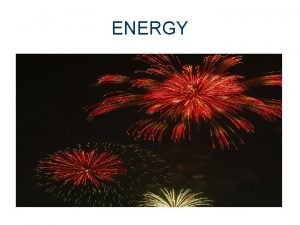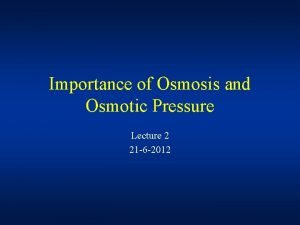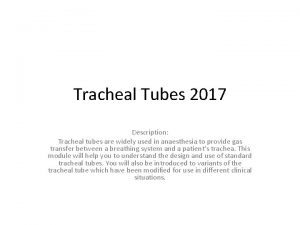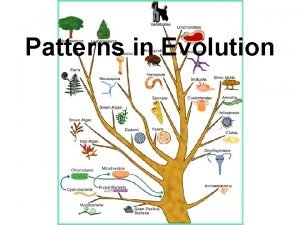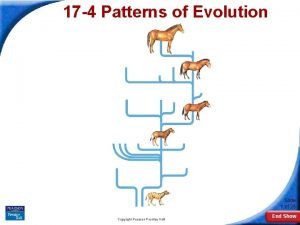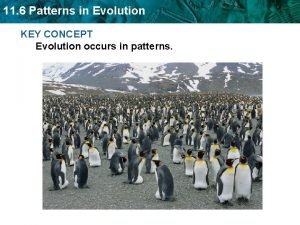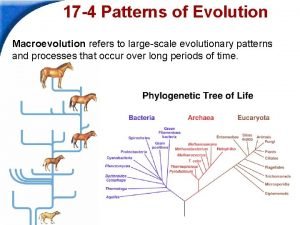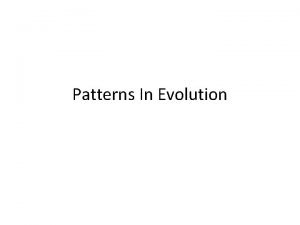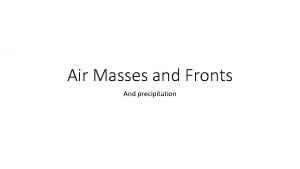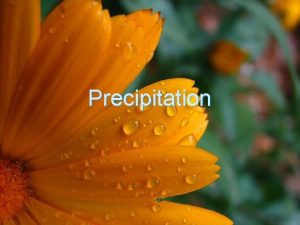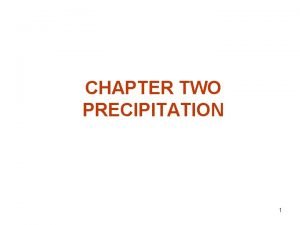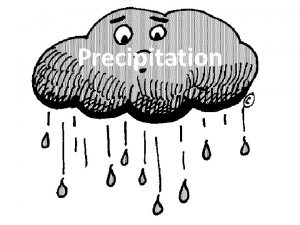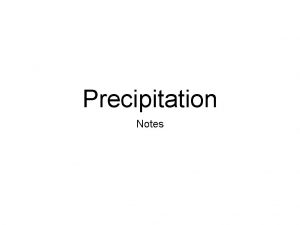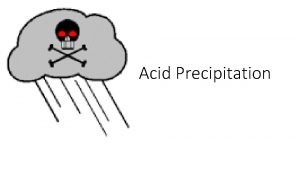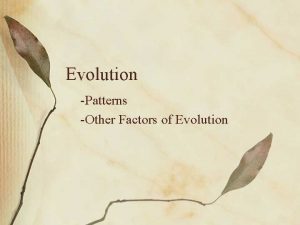Repeating Patterns of Precipitation and Surface Pressure Evolution




















- Slides: 20

Repeating Patterns of Precipitation and Surface Pressure Evolution in Midlatitude Mesoscale Convective Vortices Eric James Colorado State University 17 August 2009

Previous Studies Johnson et al. , 1989 23 -24 June 1985 OK PRE-STORM MCS “Onion-shaped” sounding at rear of MCS due to subsidence; heat bursts as subsidence locally penetrates shallow surface inversion MCV forms within dissipating stratiform region As stratiform precipitation dissipates, surface mesohigh rapidly transforms into strong mesolow, and vortex becomes visible in satellite imagery

Previous Studies Brandes, 1990 6 -7 May 1985 OK PRE-STORM MCS Cyclonic circulation forms within stratiform region, with westerly rear inflow jet to the south “Onion-shaped” soundings within rear inflow, with low-level warm and dry air Significant notch in reflectivity field, with strong mesolow at notch apex, associated with warming within rear inflow

Objectives Motivated by existence of dense surface observations by the Oklahoma Mesonet, we aim to: Identify numerous MCV cases in this region during 2002 -05 Classify cases according to precipitation and surface pressure evolution Propose some mechanisms for frequently-observed mesolows

Case Selection We run algorithm of Davis et al. (2002) on hourly RUC analyses in Oklahoma Algorithm classifies gridpoints as vortices if all criteria are met Can be run for each analysis time to derive vortex tracks; detected vortices are treated as one if track is continuous

Classification 45 vortices arise from MCSs; these MCV cases are examined in detail MCV events grouped based on evolution of parent MCS, and surface pressure signatures Five recurring types of MCVs are found: Three types produce distinct surface mesolows: Rear Inflow Jet MCV (19 of 45) Collapsing Stratiform Region MCV (8 of 45) Vertically Coherent MCV (1 of 45) Two types do not produce surface mesolows: Remnant Circulation MCV (14 of 45) Cold Pool Dominated MCV (3 of 45) Examples of mesolow-producing MCVs are presented, with hypotheses for their surface pressure effects

Rear Inflow Jet MCV: 24 May 2003 Oklahoma Mesonet (1400 -1700 UTC) Bow echo moves SE with stratiform rain to N Small mesohigh on SW end of convective line Rear inflow notch begins to develop at back edge of stratiform region, S of developing MCV Intense mesolow forms near apex of rear inflow notch

Rear Inflow Jet MCV: 24 May 2003 Haskell Wind Profiler (0700 -2000 UTC) BAMEX Aircraft (~1930 UTC) Both analyses show low-level virtual warming of ~2. 5 C, centered near 825 h. Pa, west of cool anomaly at similar height, and above ~700 h. Pa Warming occurs near base of strong rear inflow according to profiler

Collapsing Stratiform Region MCV: 9 August 2004 Oklahoma Mesonet (0800 -1100 UTC) Small dissipating MCS moves into OK from N Significant mesohigh on S edge of stratiform region Large mesolow develops within dissipating stratiform region, collocated with developing MCV

Collapsing Stratiform Region MCV: 9 August 2004 Purcell Wind Profiler (0800 -1900 UTC) ARM SGP Radiosonde (1136 UTC) RASS and radiosonde observations show deep layer of warming collocated with mesolow, evidence of dry-adiabatic subsidence at low- to mid levels

Vertically Coherent MCV: 29 July 2004 Oklahoma Mesonet (1300 -1600 UTC) Large stratiform precipitation region moves NE into E OK Cyclonic circulation of radar echoes evident in animated radar imagery Well-defined mesoalpha scale low pressure center exists at center of circulation Cyclonic circulation in mesonet winds

Vertically Coherent MCV: 29 July 2004 RUC analysis (1200 UTC) RUC cross-section of MCV shows deep, vertically coherent tower of PV directly over surface mesolow PV tower resembles that documented in BAMEX MCV of 11 Jun 2003 Both cases also have weak virtual temperature perturbations BAMEX Aircraft (~1730 UTC 11 Jun 2003)

Rear Inflow Jet MCV: Conceptual Model At MCS maturity (left), mesohigh centred behind strong convective line At second stage (middle), right-hand portion of stratiform region begins to erode from rear, mesolow begins to form at back edge of precipitation, and midlevel vortex begins to develop At final stage (right), MCS has become strongly asymmetric, with intense wake low at apex of rear inflow notch on right-hand side of system, and MCV is intensifying

Collapsing Stratiform Region MCV: Conceptual Model At MCS maturity (left), mesohigh centred in precipitation region At second stage (middle), mesohigh shifts ahead of precipitation, mesolow begins to form due to subsidence warming in dissipating stratiform region, and midlevel vortex begins to develop At final stage (right), mesohigh is weakening, mesolow has broadened and deepened within dissipating stratiform region, and MCV is intensifying

Discussion Rear Inflow Jet MCVs produce mesolows due to intense low-level subsidence warming within a rear inflow jet (i. e. , the “wake low”) This mechanism has been documented by Johnson and Hamilton (1988) and Stumpf et al. (1991) The Brandes (1990) case appears to be in this category Collapsing Stratiform Region MCVs produce surface mesolows due to broad-scale low- to midlevel subsidence warming within a dissipating stratiform region The Johnson et al. (1989) case appears to be in this category Vertically Coherent MCVs produce surface mesolows due to a deep warm core and a relatively weak surface-based cold pool The 11 Jun 2003 BAMEX MCV appears to be in this category Remnant Circulation MCVs have no precipitation in their vicinity and produce no surface pressure effects Cold Pool Dominated MCVs have extensive precipitation but no mesolow

Conclusions The Vertically Coherent MCV documented here strongly resembles an incipient tropical cyclone; further study of these systems could help us understand tropical cyclogenesis Identification of these distinct MCV types has implications forecasting: The formation of an MCV within an intense, asymmetric MCS could be a sign that wake low formation is likely, with associated high winds and low-level wind shear hazards The appearance of a broad mesolow within a collapsing stratiform region could suggest that MCV formation is likely, which plays a role in subsequent convective initiation Vertically Coherent MCVs moving off the coast over warm water should be monitored for possible tropical cyclogenesis (Bosart and Sanders 1981) Future work will involve a composite analysis of the synoptic-scale environment of the MCVs, and modeling of some cases

Tahlequah mesonet station (0700 -2100 UTC 24 May 2003) Hydrostatic pressure change associated with 1500 -1700 UTC virtual warming in Haskell profile: -0. 87 h. Pa This agrees well with observed pressure drop at closest OM station (Okmulgee): -0. 79 h. Pa Tahlequah pressure drop: -3. 62 h. Pa This suggests core of warming is not sampled by Haskell profiler

Breckinridge mesonet station (0800 -2000 UTC 9 Aug 2004) Hydrostatic pressure change associated with 1100 -1300 UTC virtual warming in Purcell profile: -1. 75 h. Pa This agrees well with observed pressure drop at closest OM station (Washington): -1. 52 h. Pa

Mc. Alester mesonet station (0600 -2200 UTC 29 Jul 2004) Purcell Wind Profiler (0600 -2100 UTC 29 Jul 2004)

Type # Vorticity (s-1) All 45 9. 98 x 10 -5 RIJ 19 1. 32 x 10 -4*** CSR 8 6. 75 x 10 -5** VC 1 8. 83 x 10 -5 RC 14 8. 21 x 10 -5 CPD 3 7. 92 x 10 -5 % Longevity (h) 100 17 225 42 15 231 18 7 Radius (km) 14 206* 2 10 262 31 24* 225 13 227 *Significantly different from the mean of all the MCVs at the 90% level **Significantly different from the mean of all the MCVs at the 95% level ***Significantly different from the mean of all the MCVs at the 99% level
 Steps of gravimetric analysis
Steps of gravimetric analysis Co precipitation and post precipitation
Co precipitation and post precipitation Repeating pattern caterpillar
Repeating pattern caterpillar Forms and uses of energy
Forms and uses of energy 17-4 patterns of evolution answer key
17-4 patterns of evolution answer key Lesson 17: patterns and processes of evolution
Lesson 17: patterns and processes of evolution Lesson 17 patterns and processes of evolution
Lesson 17 patterns and processes of evolution X videos
X videos Bernoulli rule of integration
Bernoulli rule of integration Is oncotic pressure the same as osmotic pressure
Is oncotic pressure the same as osmotic pressure High pressure and low pressure
High pressure and low pressure What is low pressure
What is low pressure Divergent wvolution
Divergent wvolution 17-4 patterns of evolution
17-4 patterns of evolution 6 patterns of evolution
6 patterns of evolution Connecting the concepts macroevolution
Connecting the concepts macroevolution Macroevolution
Macroevolution Section 17-4 patterns of evolution
Section 17-4 patterns of evolution Volume and surface area of cone
Volume and surface area of cone Surface area of triangle
Surface area of triangle Dating patterns since the 1960s are
Dating patterns since the 1960s are



